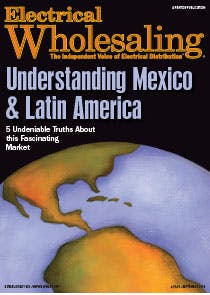The economic news hasn’t been all bad, as the construction market posted solid gains in 2015, with particular strength in the residential and commercial office sectors. But all eyes are on the industrial market. At press-time, news came out that for the first time since Nov. 2012 the Purchasing Managers Index, a key indicator for future capital expenditures in the industrial market, slid under the 50-point line that indicates growth. Economists seem split on if this is a long-term trend. At least one quoted in a recent Wall Street Journal article said the PMI seems to be tracking closely to 2012, when it skidded into no-growth territory in November, but quickly recovered the next month and climbed back to respectability during 2013.
In this year’s annual recap, Electrical Wholesaling’s editors separated 2015’s biggest news stories and emerging trends into three categories — “The Good,” “The Bad” and “The Usual.”
THE GOOD
Hurray for homebuilders. Single-family home construction may be the strongest construction segment in 2016, judging from the prognostications of some of the leading construction economists. The National Association of Home Builders (NAHB), Washington, D.C., expects single-family homebuilding to top 20% growth in 2016 and to see 30% growth in 2017. Although a key reason the residential business is seeing this degree of growth is that it’s still recovering from the historic lows it saw during the 2007-2009 recession, at least it’s heading in the right direction.
Some regional market superstars. The U.S. economy seems to have evolved into a world of “have and have not” markets, with some metros seeing insanely good amounts of commercial and residential construction, and other cities muddling through a nether-world that’s not quite in recession but is showing no better than real slow growth. Living large are cities like Boston, New York, Raleigh, Charlotte, Miami, Austin, Dallas, Houston, San Jose, Calif., San Francisco, Seattle and Washington, D.C. On the flip side, Chicago, Philadelphia, Los Angeles and Baltimore may not be doing all that bad by some measures, but they are not quite in the same orbit as the aforementioned metro leaders.
The Internet of Things (IoT) gains ground in the lighting market. While the jury is still out on exactly how much the Internet of Things (IoT) may change the everyday electrical world, there’s no doubt it’s having an impact on the lighting market. Lighting manufacturers who appear to be all-in on the concept of remotely controlling virtually any kind of lighting fixture via mobile-based apps include Acuity Brands, GE, Hubbell Lighting, Sensity and Philips Lighting, and in 2015 several of them announced moves that took them deeper into the world of connected lighting. One thing is for certain — right now plenty of product engineers are playing around with the concept of embedding sensors in lighting equipment and other IP-enabled electrical devices, including circuit breakers, industrial controls for factory automation systems and utility metering equipment.
THE BAD
The industrial market starts to head south. Key economic indicators that measure the health of this important market segment for the electrical industry are reflecting some slippage. At press-time, the PMI, capital goods expenditures, and manufacturers’ shipments are all tracking downward. The two largest reasons for the decline appear to be slackening global demand and the continuing decline of the oil and gas industry. The historically cyclical energy market hasn’t found a bottom yet according to the closely-watched Baker Hughes rig count, which at press-time showed 1,173 fewer working rigs in the United States than a year earlier.
Branch closings at Rexel, Grainger and WESCO. You don’t often hear about large-scale branch closings in the electrical market, but several of the larger distributors trimmed back their branch networks in 2015. WESCO Distribution Inc., Pittsburgh, told investors at mid-year that it had closed or consolidated six branches and expected to shut down others, and W.W. Grainger Inc., Lake Forest, Ill., announced in a press release that it would be closing 26 locations. Rexel, Paris, said in an investors’ presentation that as of June 30 its U.S. branch network had 370 locations — 25 fewer than a year ago — and that it also had shut down six Canadian branches over the same time period. There were anecdotal reports that many of the closures were in Florida.
Publicly owned electrical companies get whacked on Wall St. Oh, how far the mighty have fallen. Over the past 12 months publicly owned electrical manufacturers and distributors as a group are lagging the S&P 500 and Dow Jones Indexes, which at press-time were about even for the year. Several former Wall Street darlings stick out because of the dramatic decrease in their stock prices over the past few years. At the beginning of December, the stock prices of Grainger (down -20.2% YOY); WESCO (down 37.6% YOY); Eaton (down 17% YOY); and Generac (-29.4% YOY) were all trying to recover lost ground.
THE USUAL
Sonepar, CED, WESCO and Graybar all made significant acquisitions in 2015 but Anixter’s purchase of HD Power Solutions made the biggest splash. Anixter took a big step into the mainstream electrical market with its purchase of HD Supply’s electrical division and its $1.9 billion in 2014 sales. Time will tell how this changes the company’s historic focus on wire and cable. WESCO nabbed some blue-chip independents with its acquisitions of Hill Country Electric Supply, Austin, Texas, and Needham Electric Supply Co. (NESCO), Canton, Mass.; Sonepar added QED Supply, Las Vegas, and with its previous purchase of Codale Electric Supply is now a major player in the Intermountain region. It also bought Virginia’s Eck Supply, and companies in at least 10 other countries. Other acquisitions of note include Graybar’s purchase of Advantage Industrial Automation, Duluth, Ga.; Turtle & Hughes’ acquisition of Forest Hills Electrical Supply, Randolph, Mass.; and Electrical Equipment Co.’s purchase of Williams Supply, Roanoke, Va.
Some distributor acquisitions and other deals shuffle more areas of primary responsibility (APR) for Rockwell Automation. Electrical Equipment Co. will now be selling Rockwell Automation equipment in Lynchburg, Va., with its purchase of Eck Supply’s branch there, as well as in Williams Supply’s Virginia territory through its acquisition of that company. In the Upper Midwest, Werner Electric, Cottage Grove, Minn., took on D.S. Electric Supply’s APR and inventory in some parts of western Wisconsin, but D.S. Electric will still serve electrical customers in the La Crosse and Eau Claire, Wis., markets.
About the Author
Jim Lucy
Editor-in-Chief of Electrical Wholesaling and Electrical Marketing
Jim Lucy has been wandering through the electrical market for more than 40 years, most of the time as an editor for Electrical Wholesaling and Electrical Marketing newsletter, and as a contributing writer for EC&M magazine During that time he and the editorial team for the publications have won numerous national awards for their coverage of the electrical business. He showed an early interest in electricity, when as a youth he had an idea for a hot dog cooker. Unfortunately, the first crude prototype malfunctioned and the arc nearly blew him out of his parents' basement.
Before becoming an editor for Electrical Wholesaling and Electrical Marketing, he earned a BA degree in journalism and a MA in communications from Glassboro State College, Glassboro, NJ., which is formerly best known as the site of the 1967 summit meeting between President Lyndon Johnson and Russian Premier Aleksei Nikolayevich Kosygin, and now best known as the New Jersey state college that changed its name in 1992 to Rowan University because of a generous $100 million donation by N.J. zillionaire industrialist Henry Rowan. Jim is a Brooklyn-born Jersey Guy happily transplanted with his wife and three sons in the fertile plains of Kansas for the past 30 years.



